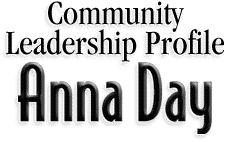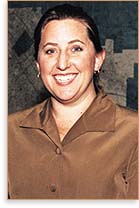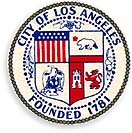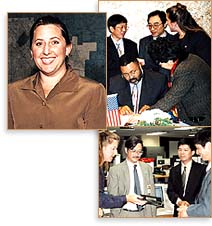
|


Emergency Preparedness Coordinator, City of Los Angeles

By Dawn Chabon

he first thing likely to strike someone meeting Anna Day is an infectious exuberance that lets them know that she loves her job.
Day has made it her life’s work to ease the suffering of others in times of natural and man-made disasters in Los Angeles, but not in the tradition of the many professions which specialize in handling such circumstances after the fact. Rather, Day works with agencies, organizations and individuals of every description throughout and beyond L.A. to help them be self-sufficient and prepared not only to minimize and rebound from disasters themselves but to see to the needs of their neighbors.
A combination of formal training, compassion and a natural graciousness makes Day someone people want to place their trust in, and for good reason. Day holds a key to matters of life and death in Los Angeles as head of the Inter-Agency, Private Sector section within the City of Los Angeles Emergency Preparedness Division.
Anna Day and her staff, under the leadership of division director Ellis Stanley, work on emergency planning and preparedness day in and day out. Her particular sector supports other departments of the Emergency Preparedness Division so that the entire city is encompassed by a comprehensive network of emergency strategies that will, when the time comes, serve the city well.
From her position, Day also serves the City of Los Angeles in her capacity as Emergency Preparedness Coordinator for Area H of Los Angeles County—one of eight areas L.A. county is divided into for purposes of emergency preparedness. Area H encompasses Los Angeles city proper.
Day is frequently out in the community. Her Inter-Agency, Private Sector team works with businesses and non-profit organizations as well as county, state and national government agencies—from the Governor’s Office of Emergency Services (OES) to the Federal Emergency Management Agency (FEMA)—to formulate strategies and develop resources for emergency handlings. She and her staff help connect private groups with city agencies and services so that the maximum amount of preparedness can be generated within each.
Acronyms such as BICEPP (Business and Industry Council for Emergency Planning and Preparedness), MARAC ([State of California] Mutual Aid and Regional Advisory Committee, DMAC (Disaster Management Area Coordinator), delineating systems within systems of people dedicated to solving problems of emergency and disaster for the massive population of Los Angeles, are common language among Day’s team, who work to coordinate all such efforts.
Her office also provides staff support to the Emergency Operations Organization (EOO), which is charged with setting general policies for emergency planning in the City of Los Angeles, consisting of the Emergency Operations Board (EOB) and the Emergency Management Committee (EMC), as well as their respective and numerous subcommittees.
“Anytime we need something from the city side of things, we go to Anna Day and she comes through for us,” said Bob Lee, board member of BICEPP since 1984 and a member of the Emergency Preparedness Commission for the County and Cities of Los Angeles who has worked with Day for years. “No matter what it is, if she says she is going to do it, you know she is going to follow through. I can depend on her.”
Teamwork a Guiding Principle
Day’s role as a key player in the overall scheme of disaster preparedness in Los Angeles suits her talents, tendencies and training to a “T.” Those who work with her have also observed that that “T” particularly stands for “Team.”
“Being a team player is a big part of my life,” says Day, who works to build individuals and groups into teams that are mutually dependent on each other—and co-workers and many Angelenos who have come to know her would agree that she is very good at it. In fact, she has been instrumental in building not just local community partnerships but alliances that literally stretch around the globe to Shanghai, China—all in the name of preparing people in the event of disaster.
.................................
“Anytime we need something from the city side of things, we go to Anna Day and she comes through for us.”
—Bob Lee, board member of BICEPP and member of the Emergency Preparedness Commission for the County and Cities of Los Angeles
.................................
|
|
Day was intimately involved in forming the union between the cities of Los Angeles and Shanghai, an event that characterizes the growing reality of a world-wide community built on trust and mutual concerns. The partnership was inspired by United Nations Resolution No. 44/236 that proclaimed the 1990s “The International Decade for Natural Disaster Reduction.” During stage one of the process, Anna hosted several delegations made up of governmental representatives from Shanghai, who observed Los Angeles systems for emergency management.
The Shanghai officials, in turn, invited representatives from Los Angeles to visit their city to learn of their emergency preparedness concerns, to discuss how they plan for emergencies, train emergency personnel and showcase their new offices currently under construction. Day and her boss, Ellis Stanley, accepted the invitation and visited Shanghai in February 1999.
Once a small fishing village, Shanghai has built more than 3,000 high-rises in the past 10 years, and will soon open the new Pudong International Airport. Unlike Los Angeles, earthquake is not a major concern in Shanghai, but floods, chemical spills and other environmental issues and construction accident rescues are, and city officials are anxious to benefit from the extensive work that has been done in Los Angeles to protect the lives of people at risk. As the visit concluded, a document bearing the signature of Los Angeles Mayor Richard Riordan was signed by Mr. Yang Sen, director of the Shanghai Municipal Civil Defense Office, establishing with the City of Shanghai a formal agreement to share information and technology and continue to work together to mitigate the effects of disaster for their city of 14 million inhabitants.
Day is currently working on forming a similar partnership with Tel Aviv, where she visited officials in early 2000 with colleague Karen Wagner, director of the Volunteer Bureau for the Los Angeles Mayor’s Office.
“Day combines knowledge with enthusiasm for what she does,” said Wagner. “As a colleague she is supportive, a team player and committed to her work.”
 A Part of Everyday Life
A Part of Everyday Life
Day’s career of helping people save their own lives rests on her strong ability to reach out with enthusiasm.
Her social nature was brought to the fore when she first realized as a young girl that she had to embrace total strangers and make them her friends in an instant. Day never had the luxury of waiting for friends to warm up to her, as her life was spent on the move, growing up in Massachusetts, England, Delaware, Ohio and ultimately California as her family moved to accommodate her father’s Air Force career.
The different locales, however, exposed Day to a variety of potential disasters. She recalls hearing about Ireland’s terrorist bombings on the nightly news when she lived in England. She remembers living through the harsh winters in New England. In Ohio, tornado warnings were as common as fire drills are for Los Angeles children. And ironically, Day’s first earthquake experience occurred in 1981 in Ohio, not California.
It was not until Day set her roots in California that she began to seriously carve out the career path that she follows today. In the summers she began serving as a lifeguard for the City of Los Angeles at Cabrillo Beach. Day noticed a “team” point of view among lifeguards and others at the first moment of any emergency; people from all the different agencies worked together to solve a problem no matter how delicate or how demanding. Everyone just pitched in. But more importantly, they could help, because they knew exactly what to do—the Los Angeles Police, Port Police, Department of Recreation and Parks, Los Angeles County, Coast Guard, City of Long Beach and even community groups would join forces and skills to address the situation until it was handled. Thus, when Day received her Master of Public Administration degree from Cal State Long Beach, she also took courses to gain skills in crisis management to expand her knowledge and understanding of how these groups worked together so successfully.
When talking to Day, it is difficult not to experience her enthusiasm for working with “all those wonderful agencies,” as she puts it—and means it—from Building and Safety to the Fire Department. “I feel privileged because I get to work with them all,” she says.
“There is a mission to be carried out,” says Day. It is the driving force behind all that she and her section do.
“The more we get individuals to prepare themselves, the more they’ll help others and take this information to their friends and workplaces. One by one, everyone will learn the benefits of preparedness. It goes without saying that a populace that is prepared for disasters is going to fare far better than one that is not. The time to tackle a disaster is before it happens.”
|

|








 A Part of Everyday Life
A Part of Everyday Life